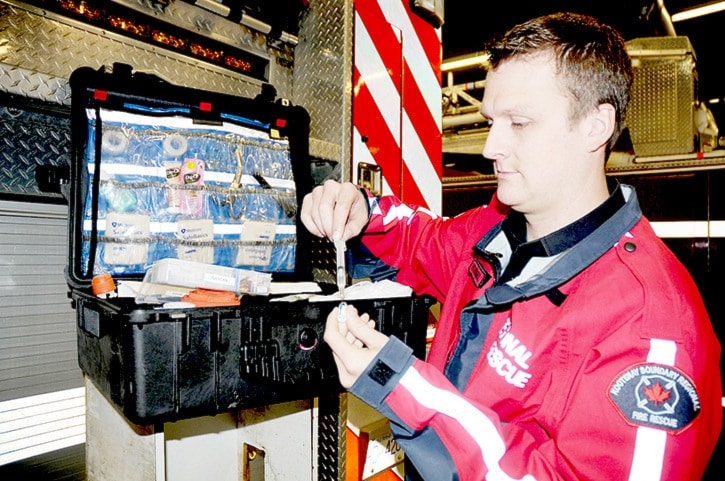Local first responders are being called out to an increasing number of opioid overdoses - sometimes even three or four times a shift.
The rise in these types of calls has prompted a pilot project in naloxone at the Regional District of Kootenay Boundary (RDKB) fire department. Often firefighters are the first responders to the scene.
Until now, the RDKB crew has been responsible for maintaining the patient’s airway until BC Ambulance arrived with a dose of naloxone, which is a medication used to block the effects of opioid on the respiratory system.
After training with the BCEHS (B.C. Emergency Health Services) regional career firefighters can now inject the drug once an airway is maintained, and monitor the patient’s response until ambulance attendants arrive.
“The calls are more frequent this year, we are definitely seeing the pattern increase,” says Grant Tyson, an 18-year firefighter. “Before Narcan (brand name of naloxone) all we could do was maintain the airway, fentanyl stops the breathing, there’s still a pulse, but we have to breathe for the person,” he explained. “It’s quite straight forward, we are still there to maintain the patient’s airway, but if BC Ambulance is delayed, we will take the next step.”
Fire Chief Terry Martin clarified that the program is only in-house at this point, naloxone training has not been rolled out to paid on call firemen in Rossland, Warfield, Genelle or the Beaver Valley.
“That is going to take some more thinking and research to see what kind of calls we are getting in the outlying areas,” he noted. “We are going to run it here first and see if it is successful.”
The drug responsible for the majority of incidents is fentanyl, an opioid up to 100 times more powerful than morphine ,and linked to hundreds of fatal overdoses in B.C. this year, including one in the Kootenay Boundary.
“This is not new to the province, it’s been really widespread throughout the Lower Mainland,” said Martin, a 25-year firefighter. “I think we are now seeing the effect of it coming to our neighbourhoods, so to speak.”
Very shortly after receiving their training, the Ministry of Health released new regulations regarding naloxone administration in B.C. - first responders are no longer required to complete BCEHS training for licence endorsement. Additionally, since March, naloxone kits have been available without prescription in B.C. pharmacies.
However, first responder training provides quality assurance and best practices which includes reporting all incidents to BCEHS.
“You don’t just go in there, draw it up and stick them with a needle,” said Tyson. “We had one guy who overdosed, (in a nearby location) BC Ambulance hadn’t arrived yet, so we (established) an airway into him,” he added. “The guy stood up and cocked his arm ready to pop one of our guys - we don’t like these kind of calls because you never know what you are walking into.”
The rise in opioid overdose from prescription and illicit drugs has become a public health issue, and often referred to as a public health crisis.
In 2015 BC Ambulance Service administered naloxone in 3094 patient overdose events to reverse opioid-related respiratory depression.
The BC Coroners Service recently reported 302 illicit drug overdose deaths with fentanyl detected from January through August 2016. This is a 211 per cent increase over the number of deaths (97) occurring during the same period in 2015. Most decedents (79 per cent) were male, and over half (60 per cent) were between 19 and 39 years of age.
Tyson noted in his experience, age doesn’t seem to matter.
“The other day there was a girl who snorted heroin and fentanyl was mixed in with it,” he shared. “It’s scary, it’s all ages, we had one lady who was 57, so it’s far reaching,” he concluded. “It’s getting worse and takes us all of us working together on patient care. But those guys on BC Ambulance, they don’t get enough recognition for what they do.”
Naloxone has been used in Canada for over 40 years and is on the World Health Organization list of essential medicines. The medication does nothing in someone who has not taken opioids, since all it does is block opioid effects in the brain. The medication cannot get a person high, and does not encourage opioid use.
